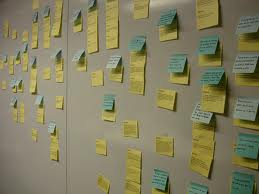Brainstorming is a method for generating a large number of creative ideas in a short period of time. Brainstorming is full of energy, moves rapidly, and is synergistic, creating a large list of ideas which may eventually be boiled down, or funneled down, to a smaller list of priority items later in the project.
When to use:
- When a broad range of options are desired
- When creative ideas are desired
- When participation of an entire team is desired
Procedure:
Materials needed: Flipchart (or large dry erase board), pens, tape, and a blank wall (to hang the completed flipchart sheets).
1. Review the rules for brainstorming with the entire group:
- No criticism. This stifles participation
- No evaluation. Evaluation can be done later
- No discussion of ideas. This tends to slow down the progress of the storm. The idea is to keep • things moving! It’s okay to get clarification, but discussions bog things down
- There are no stupid ideas. The crazier the better. Even if someone suggests an idea jokingly, add it to the list. All ideas are recorded
- Combining (also known as “piggy-backing”) and expanding on others’ ideas is encouraged.
2. The first thing to do is to review the topic or problem to be discussed. Often it is best phrased as a why, how, or what question. Make sure everyone understands the subject of the brainstorm. For example:
- Why does the approval process take so long?
- Why is the reader rework so high?
- How can we increase sales?
- What is causing defects in process XYZ?
3. Allow a minute or two of silence for everyone to think about the question.
4. When brainstorming, it is best to solicit the ideas out loud instead of using Post-it notes, or some other way of anonymously soliciting ideas. If the brainstorming session is done out loud, team members are able to piggyback on others’ ideas.
5. Invite people to call out their ideas. Quickly. Keep moving. Snap. Snap. One idea on the flipchart after another. Record all ideas, in words as close as possible to those used by the contributor. Remember, no discussion or evaluation of any ideas is permitted.
6. Continue to generate and record ideas until several minutes of silence produces no more ideas.
Variations: There are many variations of brainstorming. The one described above is sometimes called free-form, free-wheeling, or unstructured brainstorming. Another popular variation is round-robin brainstorming. In round robin brainstorming, when you invite people to call out their ideas (step 4 above), you have each person in the group say one idea in turn. If they have no ideas on their turn, they may pass. Stop the round-robin brainstorming when everyone passes.
Paring down the ideas: Upon completion of the brainstorming session, the team may want to boil down the large list into a smaller, manageable list. One might ask, if you’re trying to get to a small list, why would you ever brainstorm in the first place? If the team brainstorms 100 ideas, the probability that the best ideas are on the flipchart SOMEWHERE is high. If, the brainstorming session was skipped, the probability that the short list will be missing a key item will be greater than if the team had brainstormed the larger list first.
One quick way of paring down a large list is to give each team member five sticky dots. You tell the team members that each of them can put their sticky dots on five of the items on the list that they think are the most important. If a team member feels that one particular item is extremely important, that member might choose to put all of their five dots on that one item. There is a problem with this method though. It is quick and therefore minimizes the follow-on (after the brainstorming session) healthy discussions that could make the paring down process more effective.



